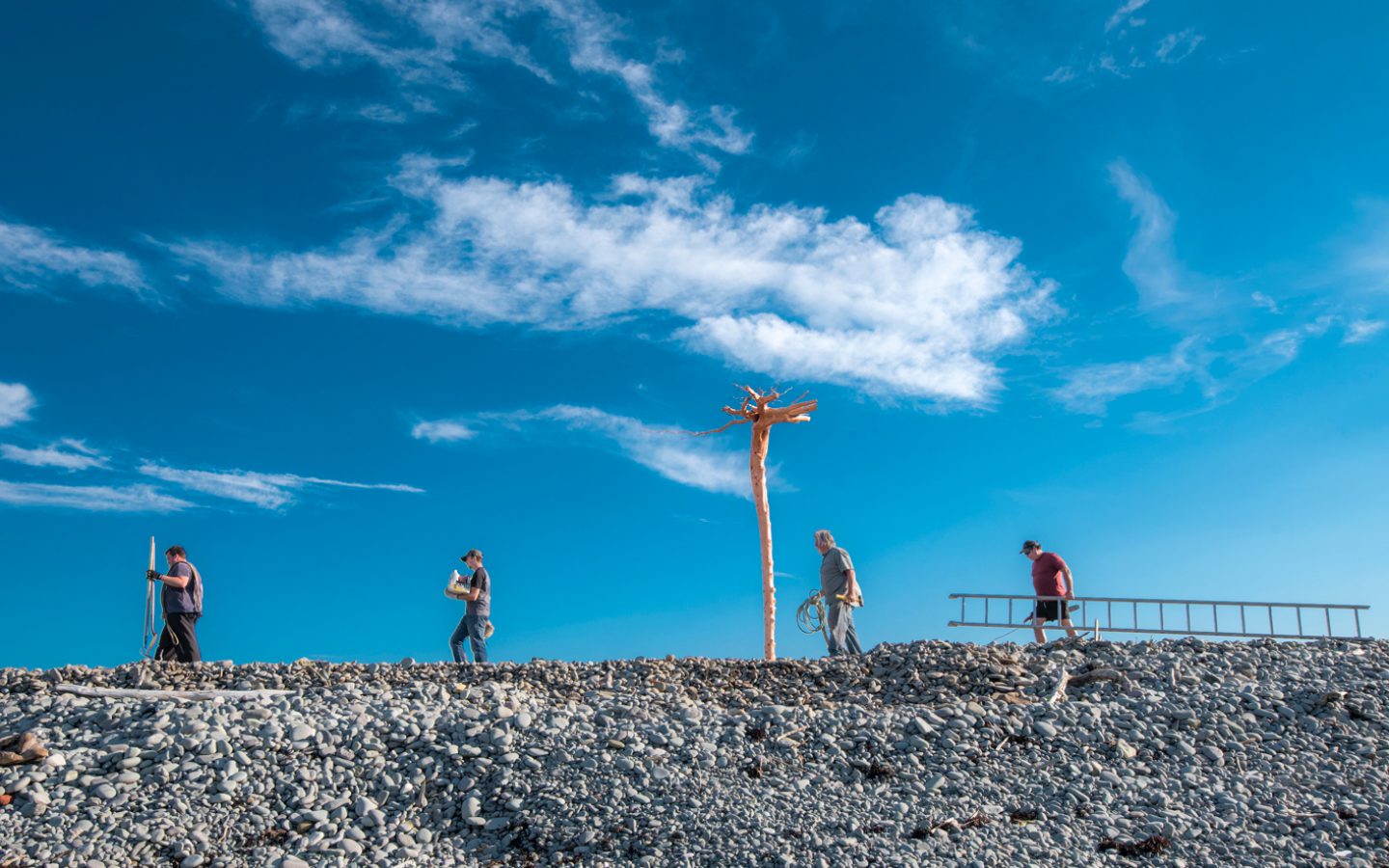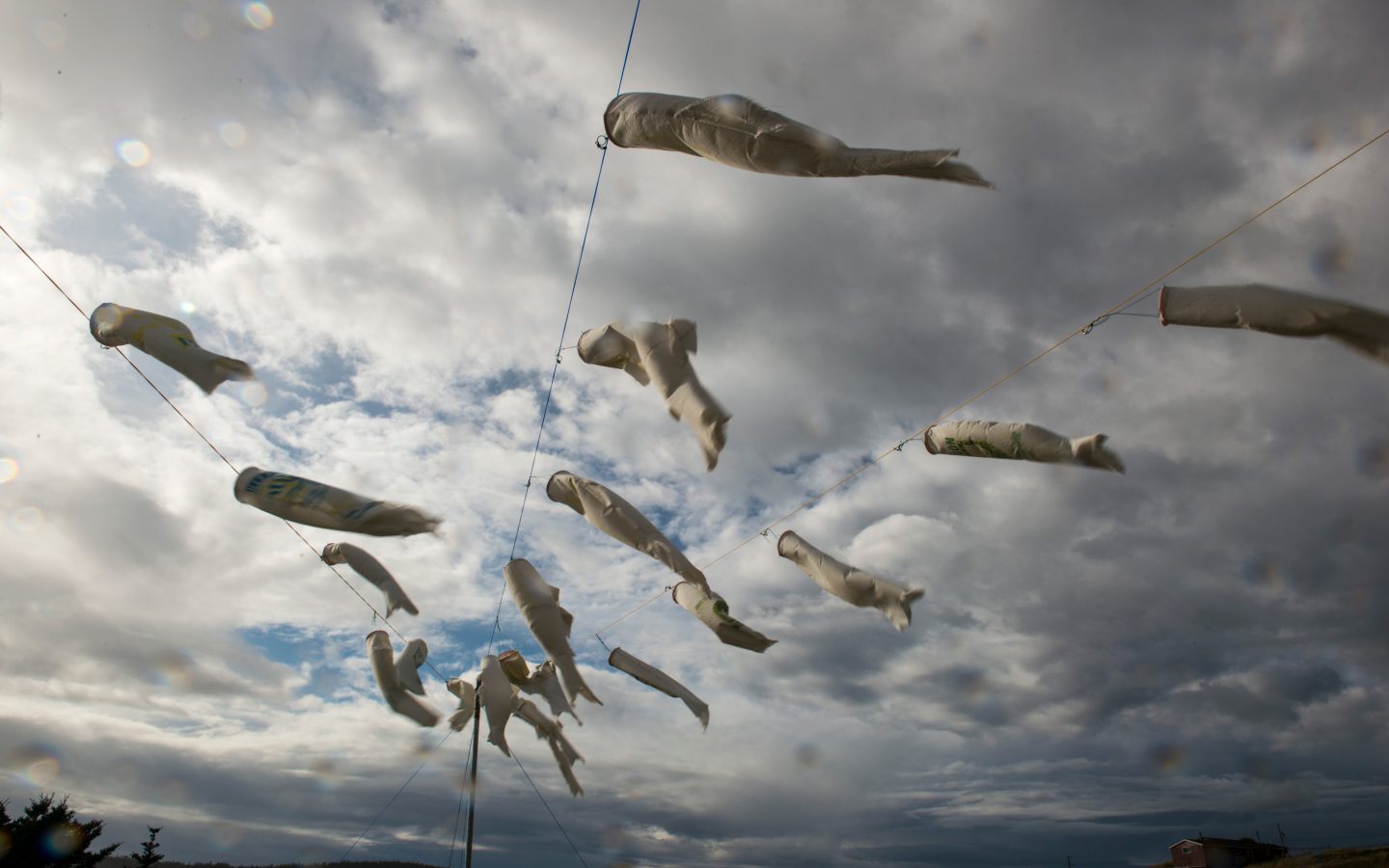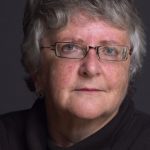An artist, curator, educator and community organizer, Catherine Beaudette has long been involved in art initiatives that position art in the public realm—from initiating independent art exhibitions in a variety of alternative spaces to founding Loop Gallery in Toronto. She is Associate Professor at Ontario College of Art and Design University, and the Founder and Executive Director of 2 Rooms Contemporary Art Projects, a non-profit contemporary art gallery, historical artifact museum and international artist residency in Duntara, NL. She lives in Duntara and Toronto.


Art encounters on the edge
Catherine Beaudette
Curator, Bonavista Biennale 2017
The Bonavista Biennale was inspired by a now-common type of contemporary art event: an exhibition held every two years, in which a large number of artists’ work is gathered internationally and brought together as a public experience. In the context of the Bonavista Biennale, this idea is modified to include a model for social change in an effort to contribute to the revitalization of the area, and to stimulate new dialogues.
Located on the eastern-most coast of Canada, the Bonavista Peninsula is a strip of land stretching 100 kilometres from its base inland to the tip of the Cape Bonavista. The single highway that wraps around the peninsula’s perimeter traces a breathtaking coastline of coves and bays. The communities that dot the shore were once flourishing fishing outports where fish as big as children were caught and salted on wooden flakes that lined the harbour. Since the moratorium on cod fishing in 1992 these communities have diminished, and some have disappeared completely. Families moved away and buildings were abandoned. It is within this environment that the Bonavista Biennale was conceived as a means of regional support and renewal on the occasion of Canada’s 150th anniversary.
Embedding the artwork within the existing historical and cultural context of the peninsula is an important component of the Biennale, activating both site and work.
Though site specificity was not a consideration in the creation of most of these artworks, a semblance of it has developed by matching artist to site and installing artwork in resonant spaces. Peter von Tiesenhausen’s video Island, for example, fills the wall of a decommissioned seal processing plant. A solitary figure wields an axe in a vast glacial landscape, carving a boat out of ice. The action is in slow motion like a dream or memory, which in this context conjures the seal hunt that happened nearby on the ice floes. The layering of meaning derived from the symbiosis of site and artwork is evident everywhere: Mason jars filled with botanical specimens glow in the darkness of a root cellar, paintings built structurally in layers hang on stud walls in an unfinished building, drawings made of dust inhabit an old house, Indigenous quill and beadwork is inserted within a replica of Ye Matthew, a ship of discovery and colonization. The counterpoints and juxtapositions of contemporary art in a site redolent with history is truly evocative.


Vision Accomplished: A conjunction of art, people and place
Patricia Grattan
Curator, Bonavista Biennale 2017
Patricia Grattan was the Director and Chief Curator of Memorial University Art Gallery for over 20 years. Now an independent curator, writer and visual art consultant based on St. John’s, NL, she works with such organizations as Tasmania’s Ten Days on the Island Festival, Queen’s University in Belfast, McMichael Canadian Art Collection and City of St. John’s. Patricia is one of five curators who recently authored The Good Lands, a book on Canadian Indigenous and non-Indigenous landscape art, published in Fall 2017. She is also the author of City Seen: Artists’ Views of St. John’s 1785-2010, named Newfoundland and Labrador Heritage and History Book of the Year, 2013. Patricia received the Royal Canadian Academy’s RCA Medal for contributions to the visual arts in Canada and was inducted into the Newfoundland and Labrador Arts Council Hall of Honour, both in 2012.
A small green chair on a rock in the ocean, washed in sunlight or lashed by North Atlantic waves. A line of red-painted trees planted upside-down along a rocky beach. A school of windsock “codfish”—150 of them—flying across a seaside meadow. This was Bonavista Biennale 2017—Art encounters on the edge.
Commissioned installations by Newfoundland artists Will Gill and Pam Hall and Ontario sculptor Reinhard Reitzenstein heralded a national exhibition of Canadian contemporary art that stretched across Newfoundland’s rural Bonavista Peninsula in late summer. The large-scale, innovative project was created by a small group of individuals convinced of visual art’s power to offer new ways of seeing the world, and seeking to build new audiences.
“Encounters” implies moments of potential, chance opportunities for discovery, learning, pleasure, communication … . Bonavista Biennale 2017 was conceived as a series of encounters with art, place and people, exhibition and experience.
“Edge” refers to both the exhibition’s contemporary nature and its location on Newfoundland’s spectacular northeast coast. The Peninsula’s historical significance made it an apt location for a Canada 150 event. John Cabot’s 1497 landfall marked the start of European settlement in Canada, with all the political, social, economic and geographical reverberations that still follow. It was less apt as an exhibition location—a somewhat remote rural area of small communities, without gallery spaces or visual art infrastructure, which had never hosted a public, curated art exhibition.
While theatre, music and literary events are part of the area’s growing cultural tourism, there is little access to contemporary art beyond summer shows in the tiny private gallery/museum space of 2 Rooms Contemporary Art Projects in Duntara on the peninsula’s east side.
But in a 2015 conversation, 2 Rooms’ Toronto-based founder, artist Catherine Beaudette, confessed her vision of a large exhibition “someday” which, like popular international urban biennials, would present many works and draw many visitors, supporting regional social and economic renewal. That vision resonated.
My own focus over 35-plus years as a curator and director in the country’s public and university gallery system has been on creating exhibition opportunities for Newfoundland artists, presenting other artists’ work within the province, and developing new audiences for art. Memorial University Art Gallery had organized provincial and national exhibition tours and projects in non-gallery sites, including Cape Spear’s World War II bunkers and a disused 1849 bank. Canada 150 celebrations and new federal funding for the Canada Council for the Arts were offering potential support for exceptional projects. With Catherine and myself as project curators, a small team, mainly resident on the Peninsula, came together. And “someday” turned into “now”.
An advance catalogue was not feasible given site-specific installations, some pieces fresh from studios, and on-the-spot adaptations within unorthodox spaces. This is a retrospective view. How fully did we meet our 2015 curatorial objectives and intertwined social, economic and community engagement goals as the project unfolded over four weeks at 23 locations throughout the Bonavista-Trinity region?
As curators, bringing different interests and experience, we set ourselves a complicated challenge. The concept was ambitious—a large national group show (emphasizing artists of Newfoundland and Labrador) at multiple outdoor and indoor sites. The sites would be integral, embedding contemporary art within community structures and space, drawing visitors into a deeper experience of place. Artwork would be characterized by diversity: artists of varied backgrounds, senior to emerging; diversity in media, content and approaches; existing, commissioned and new work.
Essential to the concept was art contemporary in issues and methodologies, and also resonant within the physical, historical and cultural context of the Bonavista Peninsula, given our goal of involving local, mainly new audiences with art and the incoming artists.
Our aim was an exhibition so strong, and an experience so novel and compelling, that we would attract not only local residents and general tourists, but also provincial, national, even international audiences interested in large, unique art events.
A time-consuming inventory of potential exhibition locations was followed by requests for their use. It remains astonishing as well as enormously gratifying that, however outlandish our project must have seemed, town councils, business owners, heritage organizations and individuals said “yes”! Only with this early community support could we move forward.
Necessity became opportunity. The diversity and unusual nature of our sites became a hallmark of the Biennale experience. Area residents encountered unfamiliar objects in familiar places—often suffused with memories—such as Swyers Hill School or the former Catalina salt fish processing plant. Visitors found art by new or nationally- and internationally-recognized artists in places they normally would not have ventured.
Each space had its own physical nature, history, and past or sometimes present role in its community, from an 18th century fish merchant’s Georgian house to a 21st century brew-pub. Our intention, reinforced by our budget, was to intervene as little as possible—for example, only installing drywall “screens” for videos in the salt fish plant’s rough industrial space, using only atmospheric natural light in an old school, or spacing Reitzenstein’s upside-down trees along Knight’s Cove barachois so that it still functions as an ATV trail.
Safe public access, security, installation issues, sometimes the ongoing functions of sites were significant factors in shaping exhibition content. As curators, we spent considerable time matching artworks and spaces. However, these were not technically-equipped, conventional, readily accessible gallery spaces: we relied on notes, experience and a great deal of intuition. Only as works were being installed in the week prior to opening could we see whether the interplay of space and art was as exciting as we imagined. In most cases, sites provided unique viewing experiences that enriched artworks’ meaning.
For instance, Catherine Blackburn’s exquisitely crafted Our Mother(s) Tongue refers to Indigenous experiences with residential schools, pain, loss of language and the more recent beginning of healing. Installation among exhibits in a centre celebrating Cabot’s voyage sharpened her small works’ large political punch. Doug Guildford’s sculptures, laboriously crocheted of fishing industry twines and wire, hung, draped and lay among museum artifacts like things plucked from the sea outside the Fishermen’s Protective Union Factory building. Natural light and the high vaulted weathered grey space of a one-room schoolhouse made a poetic container for Barb Daniell’s alchemy, transforming mundane materials into intricate totemic forms alluding to birch trees and plants’ systems.
A question for this curatorial experiment with such widely dispersed locations was whether there were enough linking “threads” to make Bonavista Biennale 2017 a coherent, or at least discernible, exhibition rather than a series of 34 installations. Given the multi-layered works of many artists, connections could be made in themes, media, methodologies or tone among disparate works and these were appreciated by those who looked for them.
Resource depletion, environmental and climate change issues underlie many works, including those of Kelly Richardson, Mike Flaherty, Marlene Creates and Pam Hall in her lament for the cod fishery, Re-seeding the Dream East. Language loss and other challenges to identity and culture are reflected on by Blackburn, Creates, Barry Pottle and Omar Badrin. Hall’s Toward an Encyclopedia of Local Knowledge project and the elaborate projections of St. Pierre and Bath deal in radically different ways with questions about past and present values and practices.
An elegiac tone suffuses series by photographers Steve Payne and Scott Walden. But Ned Pratt’s two groups of photographs are clearly of the present. His portraits of tattooed individuals, hung at Port Rexton Brewing Co., show people asserting identity: landscape-related photographs elsewhere are firmly atypical, unromantic images of the province.
Notable in several artists’ work is a deep engagement with materials and intense labour in their making: 150 hand-sewn “codfish” flour bag windsocks, crocheted fibre pieces, experimentation with solar kilns, Indigenous beadwork. Such materiality has often marked Newfoundland work, while American curator Denise Markonish (Oh Canada, MOCCA) has identified a Canadian proclivity for craft practices used with artistic purpose.
Finding art that related to the Bonavista Peninsula context was an easy matter. There are, indeed, specific local references among exhibition works, but in this global and digital era many concerns reverberate across the world—perhaps especially among rural communities and marginalized groups.
Community engagement with the Biennale, with contemporary art and with exhibition visitors was built into our structure and activities, starting with the 23-site network linking communities within an unprecedented cultural project.
It included: billeting of artists in local homes; local assistance with outdoor installations; public workshops, performances and a Speakers Series at various locations; a week-long Knowledge Exchange at Keels’ Community Hall, with Peninsula residents invited to share traditional knowledge and practices with artist Pam Hall; and all those chance encounters as viewers walked and drove the exhibition route, hiked, shopped, filled restaurants, theatres and all available accommodations. Feedback tells us that attendees particularly cherished their contacts with site attendants, local residents of varying ages, who were unjaded and thrilled to meet people from across Canada and other countries.
Collected feedback and statistics tell us that Bonavista Biennale 2017 exceeded all its goals for social and economic impact; gaining national attention among Canadian artists, curators and art media; and drawing provincial, national and some international viewers, with 70 percent journeying specifically to see the array of contemporary Canadian art. Organizers’ observations and on-the-ground experiences with visitors and residents, and the palpable excitement and animated exchanges in public venues, confirmed the thoughtful, enthused, amazed comments on social media and in letters received. (This writer had an hour-long conversation about Will Gill’s The Green Chair with an Elliston fisherman/entrepreneur, another with a young St. John’s couple on their second Biennale weekend, nearly vibrating with excitement at discovering contemporary art.)
The exhibition included revered artist Michael Snow’s well-known video Solar Breath, shot at his long-time retreat on Newfoundland’s West Coast. Snow has said of his works, “What I am trying to do is to make people see things in front of them.” Many of the 26 Biennale artists similarly call our attention to the world before us. But others illuminate what is unseen, unheard, unimagined—sounds in ocean depths, the pain of cultural loss, a spectral boat of ice. Bonavista Biennale 2017 was an audacious exhibition, unprecedented in a rural setting, bold in scale, unique in concept, rich in experiences offered: at its core was the desire to celebrate contemporary Canadian art in this Canada 150 year, in this moment of national reflection, potential and hovering possibilities.
